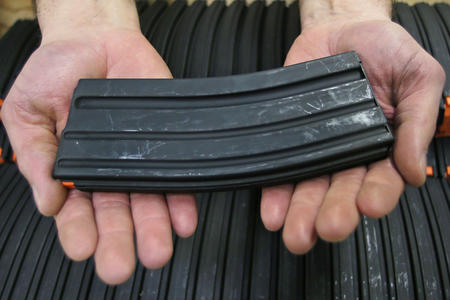Editor's Note: This piece originally appeared in www.The Tyee.ca.
Since Sept. 17 the streets of south Manhattan have been chockablock with people protesting — what, exactly? At times not even they seem sure, perhaps because their cause for being there is so vast and miasmic that they can grab hold of any part of it and make a credible claim for anger. Banks too big to fail. Soaring college costs (and debt) in a time of jobless youth. Cronyism, lobbyism, corporatism, deregulation. It all falls under a hashtag that began far from the pepper spray and mass arrests, in the offices of Vancouver's Adbusters magazine, as #OccupyWallStreet.
The movement has been at turns derided by Republican presidential candidates ("I think it's dangerous, this class warfare," Mitt Romney said.) and by major media (quoth a New York Daily News editorial: "This bunch ought to get down on their knees in thanks that America's capitalist Founding Fathers saw fit to protect the privileges of the dumb and obnoxious along with everyone else"). Nonetheless it has mushroomed from a few die-hards in the early going to a pulsing micro-city of thousands and has spawned smaller protests around America. Unions and student groups have joined in solidarity, and on Oct. 15, Toronto and Vancouver will see their own "Occupy" demonstrations.
Although it was inspired by the methods and successes of the Arab Spring, the original expectations were more muted. When Vancouver-based Adbusters presented the idea to the world, it did so in the form of a poster that featured a dancer posed on the shoulders of the Wall Street bull statue, a foggy clamour of demonstrators behind her. The poster asked the question, "What is our one demand?" Activist groups seized on it, as did the hacktivist group Anonymous, and a collective began to form. The arrests of 700 demonstrators on the Brooklyn Bridge on Oct. 1 pushed the event to the fore of media coverage.
To hear tell from Adbusters founder and editor Kalle Lasn now, the question of that one demand still needs to be answered concisely and directly. But as the movement overspills Wall Street, he describes it as the most successful in the 22 years he and his magazine have been advocating "culture jamming," which originally sought to subvert consumerism. Lasn sat down in the office of Adbusters — south of False Creek, with a fine view of downtown Vancouver — to address that singular demand, his renewed faith in the left and the soft power of ballerinas.
On the ballerina atop bull imagery of Adbusters' original #OccupyWallStreet poster:
"To me it was a sublime symbol of total clarity. Here's a body poised in this beautiful position and it spoke of this crystal-clear sublime idea behind this messy business. On top of the head it said, 'What is our one demand?' To me it was almost like an invitation, like if we get our act together then we can launch a revolution. It had this magical revolutionary feel to it, which you couldn't have with the usual lefty poster which is nasty and visceral and in your face. The magic came from the fact this ballerina is so sublimely tender.
"There's some idea there, and the power of it comes from the fact that most of the time you'll never be able to answer what it is. It's just there. It's just a magic moment that you can feel in your gut that it's there, and you're willing to go there and sleep there and go through the hardship and fight for it. Once you start answering it too clearly then the magic is gone."
On the revolt's many parents:
"We have a network of 90,000 culture jammers who are tuned in to us at various levels. The biggest brainstorms happened between myself and Adbusters' senior editor Micah White, who lives in Berkeley. We were the two key people who got excited, and more and more excited, morning after morning, and eventually decided on that hashtag, #OccupyWallStreet. When we launched that hashtag, the twittering came on so hard and fast that it drove us. We suddenly said, 'Hey, this could actually happen.'
"Anonymous gave us that — I don't know what you call it, that sort of anarchy cred. All of a sudden this organization that has this strange mystique to it, they're saying, 'Yeah, occupy Wall Street!' That first video of theirs was quite a delightful little piece of videomaking, and at that moment I could feel that we got a mighty boost forward.
"We always thought of ourselves as the catalyzers, the people who set that meme, as we like to call it, in motion. And right from the start we decided that we're not going to play a part on the street, that if our meme flies, if people love it, then we're happy to come up with posters, and we did send them all kinds of handbills and we sent them corporate America flags. So we left it pretty well up to them.
"But we do try to influence it on the deeper level. Our poster said, 'What is our one demand?' They didn't like that. And we thought it was very important, for them to have peoples' assemblies and for them to demonstrate how radical democracy really works. We thought it was a mistake for them not to discuss what some of the demands could be, and we pushed them very hard to get some of their demands together, so when a New York Times reporter phones you up and says, 'What do you want?' that you can at least answer that question. That debate is still continuing now, about whether we should have that one demand.
"I've felt like this all my life and even though I'm kind of an old guy now, I must admit age doesn't seem to come into it. I feel like this is the first time in the 20-plus year history of Adbusters that we really have a chance to pull something off, and it's we. Let's face it, most of the people, probably 90 percent of the people camping out on Wall Street are young people, and even though I'm not sleeping there I still feel it's we. It takes old people like me and theoreticians like Michael Hardt and Antonio Negri, who are writing for our next issue, and people like David Graeber, the anarchist, and Saul Newman, the guy who recently wrote a book about anarchism. It takes all kinds of people to launch a revolution, but the cutting edge is young people who put their asses on the line."
On watching the occupation from afar:
"I must admit I was very buoyed that people immediately started organizing in New York, and we knew that this thing was going to happen, even weeks in advance, that there were pre-meetings. But, you know, when that first Saturday came, Saturday, Sept. 17, then I did have this feeling that the whole damn thing could fizzle, and that we would be there for a day, and if we were lucky half a dozen people would stay there all night, and the whole thing could be just a puff of wind that came and went.
"It has grown beyond anything I thought was possible in the early days. The mood changes every day, and this realization that all of a sudden it's a nationwide movement in the United States and now it's even creeping into Canada. That's — what can I say? It's beyond anything I imagined early on. I've been sort of running with it day by day, and now it feels like anything is possible. It's a good lesson for me. I've always been reticent and careful and doing a lot of planning and stuff. For me personally it's told me, don't hold back. Just go for it. You never know what'll happen.
"The most remarkable thing that inspired me, when I first started looking at the original videos that first started appearing on Russian TV, and other videos that were made, and they went up to people in Zuccotti Park and asked people, I just couldn't believe how articulate and how tuned in these people actually were. I'd gone along with this feeling that a lot of the political left is just a loony left, and there's a bunch of granola people running around saying, 'We want to overthrow capitalism,' and that sort of stuff. Here we are brainstorming, trying to come up with slogans, and all of a sudden they were spontaneously saying things in the street that inspired me. They said it better than what we could come up with in our brainstorming sessions! That told me that maybe the political left isn't as loony as I'd been thinking for the past 10 years. Maybe there is a spark of revolutionary fervor there after all."


On harnessing the momentum established thus far:
"We know there's going to be another big moment Oct. 15 when the people in Europe start getting their act together. And then now we are sort of strategically trying to up the level and see if we can't pull off something even crazier than Occupy Wall Street, whether we can pull off a sort of global Tahrir moment.
"I know it sounds kind of grandiose, but it seems like on Nov. 3 and 4, when the G20 meet, it is possible to have millions of people marching around the world, all demanding one thing. And we believe that one thing could be the Robin Hood tax. The Tobin Tax, what we're calling a one percent tax on all financial transactions. And this could be a tipping point moment where we the people tell our politicians and our leaders what we want to happen to our economy, rather than having to listen to their bullshit about shall we have a stimulus or shall we not, or shall we do this or shall we not. Let's slow down fast money with a Tobin Tax, and we feel that over the next one month we may be able to instigate a global movement where the young people of the world stand up and say, 'We want to have a Robin Hood tax.'"
On the possibility of an American version of regime change:
"For the last 20 years we've been talking about cultural revolution and we've launched various campaigns. Something kind of magical happened around the time that that guy burned himself in Tunisia, and it suddenly sparked that regime change in Egypt. There was something about the way it was generated by Facebook and Twitter and a few key people, very creative people who did something on some website and called for people to go out in the street and then expecting 500 or 5,000 and all of a sudden they got 50,000. Strategically it suddenly became possible to get a huge number of people who are angry about something, or who are deeply concerned about something, it's possible to get them out and to get them to strut their stuff. So that was the inspirational moment that we talked about a lot in our brainstorms here.
"We decided in our brainstorming sessions that regime change in America wouldn't be like regime change in Egypt, obviously, because it's a totally different kind of a situation. We don't have some torturous dictator that's calling the shots in North America, or in America. But it did feel like there was this kind of a soft regime that was controlled by the power of finances and by the power of lobbyists and by the power of corporations to get their own way. And it felt like some kind of a soft regime change was necessary there. So we felt, to put it succinctly, that a Tahrir moment for America was in the cards, was definitely possible."
On why it took three years after Lehman Brothers' implosion for people to storm the streets:
"When the financial meltdown happened, there was a feeling that, 'Wow, things are going to change. Obama is going to pass all kinds of laws, and we are going to have a different kind of banking system, and we are going to take these financial fraudsters and bring them to justice.' There was a feeling like, 'Hey, we just elected a guy who may actually do this.' In a way, there wasn't this desperate edge. Among the young people there was a very positive feeling. And then slowly this feeling that he's a bit of a gutless wonder slowly crept in, and now we're despondent again.
"On the Egyptian side, even though their techniques were very inspiring, in the beginning there was this feeling that this doesn't apply to us. This applies to nations who have monsters like Mubarak who routinely torture people every day. Theoreticians and pundits say now, people I talk to, that ultimately this Tahrir moment that happened in Egypt, that it ultimately will apply more to first world countries and to young people all around the world, that soft regime change may actually be the great achievement of what Tahrir taught us."


